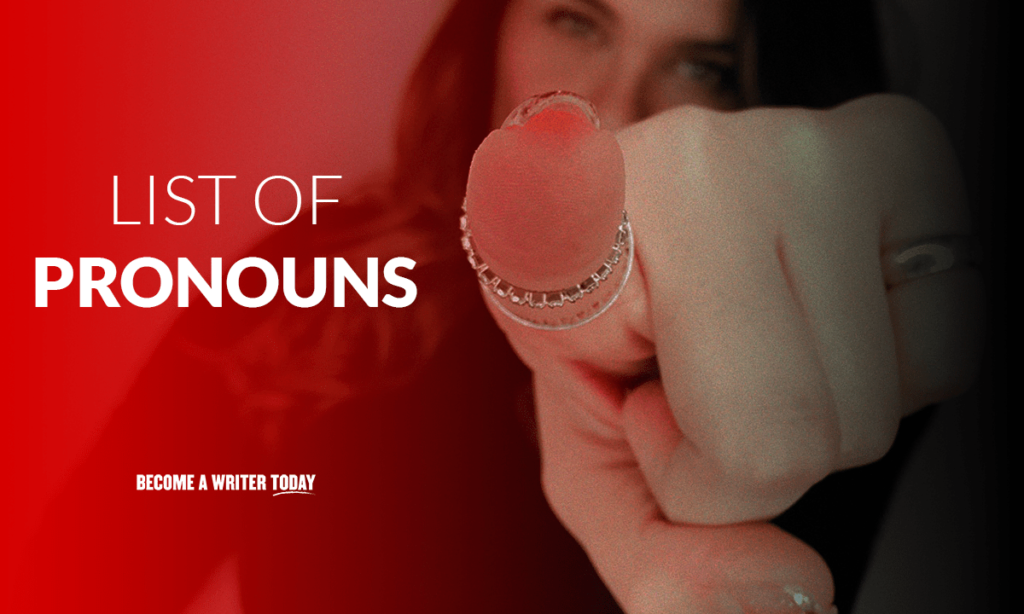When you think of pronouns, chances are you have a small list of pronouns that comes to mind. The English language has over 100 pronouns, learn more below.
To make your writing strong, you should be using pronouns accurately. This list of pronouns will help you use them properly, keep your writing varied and give you a better handle on pronouns and their antecedents.
Contents
List of Pronouns – Understanding Pronoun Types and Uses

Before studying a random list of pronouns, you need to first understand what pronouns are and how they work in sentences.
What Is a Pronoun?
A pronoun is a word that replaces a noun, usually after the noun is identified. Consider this passage:
- Sally picked up Sally’s book off of the table. Sally put the book in Sally’s book bag, then Sally got in the car to go to school.
This sentence clearly has too many repeated usages of “Sally” and “book.” It more succinctly reads:
- Sally picked up her book off of the table. She put it in her book bag, then she got in the car to go to school.
The words she, her and it all replace nouns in the previous example. These words are pronouns. The English language has several types of pronouns, which include these:
1. Personal Pronouns
Personal pronouns, which some people call subject pronouns, replace the subject of the sentence. These words also can represent the person speaking or the person the author is speaking to. Here is an example sentence:
- I want to go to the store.
Examples include:
- I
- We
- You
- He
- She
- It
- They
All of these are singular except for they and we, which are plural, and you, which can be either plural or singular.
2. Object Pronouns
Object pronouns or objective case pronouns are the words you use when replacing the object of a verb or a preposition. They can serve as the direct object, indirect object or object of the preposition. Here is an example:
- Susanna gave the bill to us on our way out the door.
These include:
- Us
- You
- Her
- Me
- Him
- It
- Them
The plural pronouns are us and them, while you can be both a plural and a singular pronoun.
3. Possessive Pronouns

Possessive pronouns show ownership of an item, without the need for an apostrophe s. These serve as possessive adjectives and can also take the place of noun phrases that designate ownership. Here is an example:
- The children picked up their books at the library
These pronouns include:
- Mine
- Ours
- Yours
- Hers
- Theirs
- His
Theirs and ours are the plural pronouns, and yours can be either.
4. Reflexive Pronouns
These pronouns all end in “self” for singular and “selves” for plural. They show the actions someone or something did prior in the passage.
To understand the function of these pronouns, consider this example sentence:
- She showed the picture to the art judge all by herself.
These pronouns include:
- Themselves
- Yourself
- Myself
- Yourselves
- Himself
- Itself
- Herself
- Himself
5. Intensive Pronouns
The intensive pronouns are identical to the reflexive pronouns. However, they do not show the action of something someone did prior. Instead, they show emphasis.
Here is an example of how they appear in a sentence:
- I, myself, am not a fan of turkey at Thanksgiving.
Here are the intensive pronouns:
- Themselves
- Yourself
- Myself
- Yourselves
- Himself
- Itself
- Herself
- Himself
6. Indefinite Pronouns
Indefinite pronouns sometimes do not identify an antecedent. These pronouns are used in situations where you need a pronoun, but need to be vague about what it replaces. Here is an example:
- Anybody can run for student council if they wish.
The indefinite pronouns include:
- All
- Another
- Any
- Anybody
- Anyone
- Anything
- Both
- Each
- Either
- Everybody
- Everyone
- Everything
- Few
- Many
- Most
- Neither
- Nobody
- None
- No one
- Nothing
- One
- Other
- Others
- Several
- Some
- Somebody
- Someone
- Something
- Such
7. Relative Pronouns
Relative pronouns start dependent clauses. They do have an antecedent, and often the antecedent comes right before the pronoun. Here is an example:
- The child that left their coat on the bus was cold on the hike.
The relative pronouns are:
- As
- That
- What
- Whatever
- Which
- Whichever
- Who
- Whoever
- Whom
- Whomever
- Whose
8. Interrogative Pronouns
As the name implies, interrogative pronouns indicate a question. They do not always so up in interrogative sentences, but they do leave a question in the mind of the reader. For example:
- Who called me today?
- Do whichever you choose.
These pronouns include:
- What
- Whatever
- Which
- Whichever
- Who
- Whoever
- Whom
- Whomever
- Whose
9. Demonstrative Pronouns
Demonstrative pronouns relate to one specific person or thing. That person or thing may not be in the sentence, but the reader knows who or what it is. Here is an example:
- I do not care for those blueberries.
- Such is the nature of love.
Here are the demonstrative pronouns:
- Such
- That
- These
- This
- Those
10. Archaic Pronouns
Some pronouns show up in classic literature, but they are rarely part of everyday English. These are called archaic pronouns. For example:
- Thou shall not kill.
They include:
- Thou
- Thee
- Thy
- Thine
- Ye
11. Non-Binary Pronouns
Many pronouns, like he and she, have gender. He, his and him are male pronouns, while she, her and hers are female.
The transgender community prefers to either use gender-neutral pronouns, like the plural form they, or newly created pronouns for their community. Some gender-neutral pronoun examples include:
- Zie/sie/ey: replaces he and she
- Zim/sie/em: Replaces him and her
- Zir/hir/eir: Replaces his and her
- Zis/hirs/eirs: Replaces his and hers
- Zieself/hirself/eirself: Replaces himself and herself
Person and Pronouns
in addition to having gender, pronouns also indicate the point of view of the writing. Writers can use third-person, first-person or second-person pronouns.
The first-person pronouns indicate the speaker. They include:
- I
- Me
- Us
- We
- Our
- Ours
- Myself
- Ourselves
The second-person pronouns include the listener, and they are:
- You
- Yours
- Yourself
The third-person pronouns do not include the reader or the speaker. They include:
- He
- His
- Him
- She
- Her
- Hers
- Himself
- Herself
- They
- Them
- Their
- Themselves
A Final Word on List of Pronouns
Pronouns can take the place of a noun in just about any part of a sentence. They require an antecedent, even if it is not clear to the reader whom the antecedent is, and must agree with the antecedent in gender and number.
As the English language is constantly evolving, the pronouns we use are also evolving. Understanding these changes shows why some pronouns, like thee and thou, are no longer in favor, while others, like ze, zie and zim, are newly integrating into society.
Either way, to be a strong writer, you must know how to use pronouns correctly. Keep this list handy to help you nail them down.
FAQs About a List of Pronouns
What are third-person pronouns?
The third-person pronouns are pronouns that do not address the speaker or the reader directly. They include:
He
She
His
Hers
Him
Her
They
Them
Their
Themselves
Himself
Herself
What are the 7 pronouns?
There are over 100 pronouns in the English language. Most people think of subject pronouns first, and the seven subject pronouns are:
He
She
They
It
Me
You
We